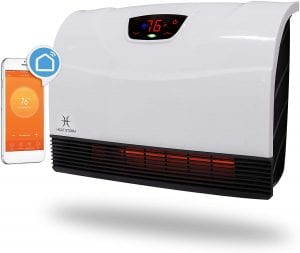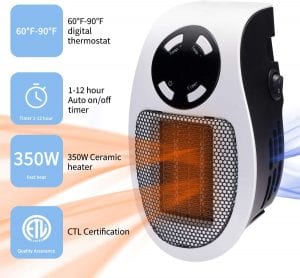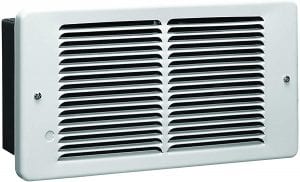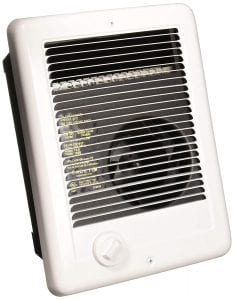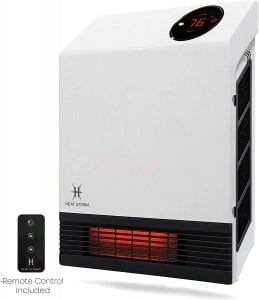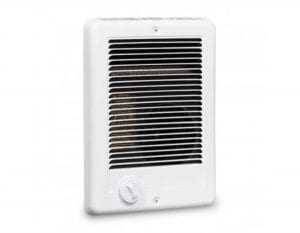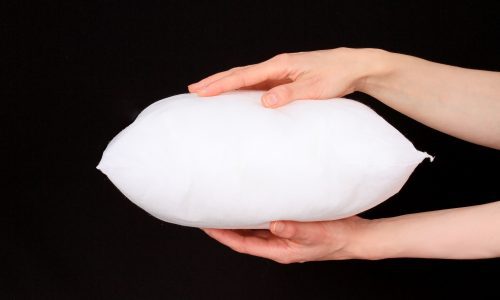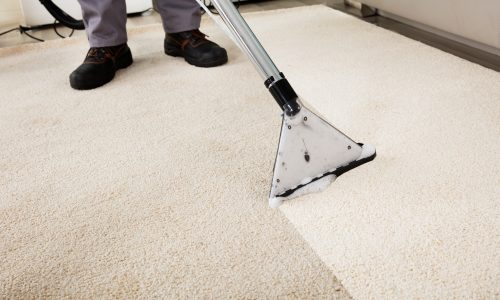The Best Wall Heater
We looked at the top 6 Wall Heaters and dug through the reviews from 20 of the most popular review sites including and more. The result is a ranking of the best Wall Heaters.
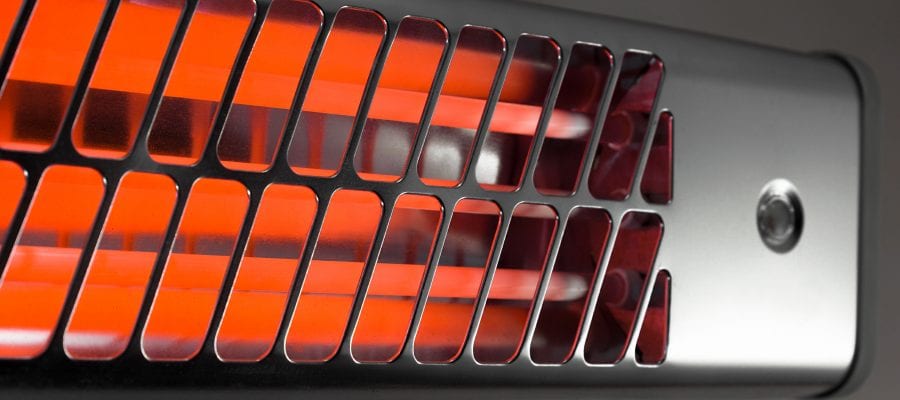
Our Review Process
Don't Waste Your Money is focused on helping you make the best purchasing decision. Our team of experts spends hundreds of hours analyzing, testing, and researching products so you don't have to. Learn more.
Our Picks For The Top Wall Heaters
- 1. Heat Storm HS-1500-PHX-WIFI Infrared Wifi Wall Heater
- 2. Minetom 350W Compact Electric Adjustable Wall Heater
- 3. KING PAW 2422-W 2250W PAW Electric Wall Heater
- 4. Cadet Com-Pak 1500W Thermostat Electric Wall Heater
- 5. Heat Storm Deluxe Infrared Wall Heater
- 6. Cadet CSC101TW 120V Com-Pak Plus Wall Heater
Equipped with a range of smart features, this is a good all-around model for both safety and efficiency. The vent shields won't burn pets or children thanks to their specialized material, and the compact size makes it ideal for small rooms.The temperature can be controlled by remote or through a smartphone app.
Safe, Smart HeatingThis compact, high-tech heater is ideal for small rooms or areas where pets and children are a concern.
This heater operates significantly quieter than other models and is great for smaller work areas or bathrooms. It operates very efficiently on low wattage and has a timer you can use for overnight heating. The temperature can be controlled down to individual degrees — a nice perk.
Quiet, Compact ModelKeep precise control over the heat in smaller rooms with this quiet, compact unit.
This lightweight heater is suited for a variety of spaces. It is powerful enough for larger rooms, but has a wattage control that can be adjusted to save power in smaller spaces. Installation is easy for almost anyone.
Powerful and AdjustableRely on this powerful wall unit for rooms both large and small.
This heater is a workhorse that can operate efficiently in a range of spaces. It installs in a jiffy and heats up quickly, bringing most small areas up to room temperature in minutes. The silent operation is a bonus.
Heats Up QuicklyThis quick-heating model can warm up most areas in minutes.
Buying Guide
With the first months of winter come a few surprises. Some are pleasant, like the first few flakes of snow or the appearance of pumpkin spice flavors in everything from coffee to beer. And some are less welcome, like the sudden spike in your heating bills.
The reason is easy to understand, yet it seems to surprise us every year: Heating a home requires lots of energy. When the thermometer starts dropping, your central air starts blowing hot air into every room in the house – even the ones you may not be using. It’s a waste, but too many of us shrug and write it off as the cost of comfort.
For smaller families or those that use one or two rooms for most of the day, there’s a cheaper alternative: A wall heater. This compact unit works independently of your central air conditioning, heating a single room for a fraction of the energy needed to warm up the entire house. Wall heaters are a step up from a space heater and are far more energy-efficient, typically mounted inside a recess in the wall. That requires a little more installation know-how but nothing that relatively ambitious homeowners won’t be able to tackle.
The first thing you’ll want to do before shopping for a wall heater is a little bit of simple math. Take the room you plan on heating and figure out the square footage. (That’s the length of your room multiplied by the width.) Now take that number and multiply it by 10 if it’s a low-ceilinged, well-insulated room. If it’s an older, less secure space with (for instance) cracks in the window frame, multiply by 15. Now you’ve got a general idea of what kind of wattage output you’ll need from a wall heater to efficiently warm up that room. A well-insulated 200 square foot room, for instance, would need a 2000-watt heater, or something in that general range.
if you’re heating larger rooms, you may want to consult an electrician even if you’re confident that you can install the unit yourself. Standard house circuits in the United States can usually handle devices that draw up to 120 volts (which is separate from wattage; you can find the specs on any heater). Any higher than that, and you may need to have a separate circuit installed. Depending on how you use your heater, this will still save you money on energy bills in the long run.
Now you’ll want to consider the type of wall heater, and that depends a lot on how you’ll be using the room. Is it meant to be a quiet space where kids might be sleeping? Or will there be plenty of TV noise or conversation to cover the hum of a heater? Will you need the room heated up quickly or can you be comfortable with a “slow burn”?
Most wall heaters are electric, but there are various differences in the actual heating elements, each with their own strengths and weaknesses. If you want a room heated quickly, a forced-fan or blow heater is the style you need. As the name implies, this kind of heater lets the fan do the heavy lifting, shooting air through heated coils and blowing it back into the room.
Convection heaters rely on the natural circulation of air to work, drawing cooler air through the bottom and letting it rise as hot air through an upper vent. This may not heat up a room quite as quickly, but it is generally quieter than forced-fan heaters. If you’ve already got a ceiling fan in the room, you can expect this kind of heater to work a bit more efficiently.
Less common is the micathermic heater, which is catching on with some more energy-conscious homes. That’s because this type of unit uses the unique conductive properties of mica stone, which disperses electromagnetic rays when properly heated. The result is a combination of radiant and convective heat that can warm up a room with much less energy.
There are a number of other features that can make or break your purchase, depending on where and how you use your heater. One of those is temperature control. Some heaters have a bare-bones approach with a variety of settings somewhere between “low” and “high.” Others have an internal thermostat and will allow you to set the desired temperature for the room — just like your central air conditioner. For a little extra safety, you may want to get a model that has an automatic shut-off feature if the heater has been running for a certain amount of time. Remember, you’re getting that heater for efficiency, and it won’t save you money if it’s running 24/7.
Speaking of safety, consider the people (and pets) that might be in the room. Wall heaters can attract the attention of small children, and if you have them around you may want to make sure your wall heater has a grill and surface that’s cool to the touch even when in operation.
Why we recommend these wall heaters?
Products Considered
Products Analyzed
Expert Reviews Included
User Opinions Analyzed
Our experts reviewed the top 6 Wall Heaters and also dug through the reviews from 20 of the most popular review sites including and more. The result is a ranking of the best of the best Wall Heaters.
DWYM is your trusted roduct review source. Our team reviews thousands of product reviews from the trusted top experts and combines them into one easy-to-understand score. Learn more.
The Best Bang For Your Buck
Minetom 350W Compact Electric Adjustable Wall Heater
Key Takeawy
This heater operates significantly quieter than other models and is great for smaller work areas or bathrooms. It operates very efficiently on low wattage and has a timer you can use for overnight heating. The temperature can be controlled down to individual degrees — a nice perk.
What to Look For
Appearance might be the last thing on your mind when buying a heater, but remember that, unlike a central air vent, it will be an obvious fixture in any room. Make sure it matches the decor. Looks typically won’t be a concern if you’re buying the heater for a garage or shed, but consider the materials. Cheap heaters may degrade quickly if they’re exposed to outdoor conditions or excessive humidity for very long.
More to Explore
Which came first, electricity or central air conditioning? You might think electricity, but the ancient Romans couldn’t wait that long for comfort. Over 2000 years ago, wealthy Romans were using a hypocaust to heat their homes. The hypocaust was basically a system that funneled heat from a furnace into a basement area that supported the home on columns, then allowed it to rise through vents in the walls.

